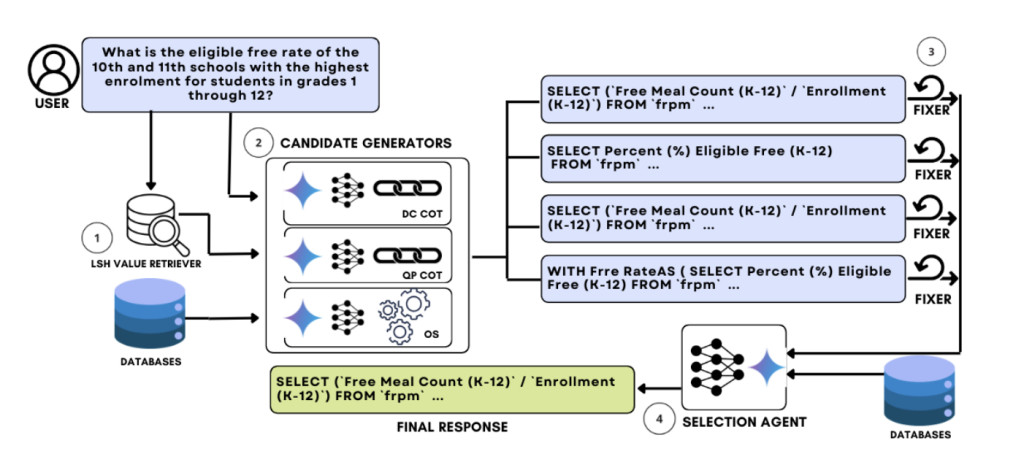An essential bridge connecting human language and structured query languages (SQL) is text-to-SQL. With its help, users can convert their queries in normal language into SQL commands that a database can comprehend and carry out. This technology makes it easier for users to interface with complex databases, which is especially helpful for those who are not proficient in SQL. This feature improves the accessibility of data, allowing users to extract important features for machine learning applications, generate reports, gain insights, and conduct effective data analysis.
LLMs are used in the broader context of code generation to generate a huge number of potential outputs from which the best is chosen. While producing several candidates is frequently beneficial, the process of choosing the best output can be difficult, and the selection criteria are essential to the caliber of the result. Research has indicated that a notable discrepancy exists between the answers that are most consistently provided and the actual accurate answers, indicating the need for improved selection techniques to improve performance.
In order to tackle the difficulties associated with enhancing the efficiency of LLMs for text-to-SQL jobs, a team of researchers from Google Cloud and Stanford have created a framework called CHASE-SQL, which combines sophisticated techniques to improve the creation and choice of SQL queries. This method uses a multi-agent modeling technique to take advantage of the computational power of LLMs during testing, which helps to improve the process of producing a variety of high-quality, diversified SQL candidates and choosing the most accurate one.
Using three distinct approaches, CHASE-SQL utilizes the innate knowledge of LLMs to generate a large pool of potential SQL candidates. The divide-and-conquer strategy, which breaks down complicated inquiries into smaller, more manageable sub-queries, is the first way. This makes it possible for a single LLM to effectively manage numerous subtasks in a single call, simplifying the processing of inquiries that would otherwise be too complex to answer directly.
The second approach uses a chain-of-thought reasoning model that imitates the query execution logic of a database engine. This method allows the model to produce SQL commands that are more accurate and reflective of the underlying database’s data processing workflow by matching the LLM’s logic with the steps a database engine takes during execution. With the use of this reasoning-based generating technique, SQL queries can be better crafted to align with the intended logic of the user’s request.
An instance-aware synthetic example generation methodology is the third approach. Using this method, the model receives customized examples during few-shot learning that are specific to each test question. By enhancing the LLM’s comprehension of the structure and context of the database it is querying, these examples enable more precise SQL generation. The model is able to generate more efficient SQL commands and navigate the database schema by utilizing examples that are specifically related to each query.
These techniques are used to generate SQL queries, and then CHASE-SQL uses a selection agent to identify the top candidate. Through pairwise comparisons between many candidate inquiries, this agent uses a fine-tuned LLM to determine which query is the most correct. The selection agent evaluates two query pairs and decides which is superior as part of a binary classification approach to the selection process. Choosing the right SQL command from the generated possibilities is more likely with this strategy since it is more reliable than other selection strategies.
In conclusion, CHASE-SQL sets a new benchmark for text-to-SQL speed by producing more accurate SQL queries than previous approaches. In particular, CHASE-SQL has obtained top-tier execution accuracy ratings of 73.0% on the BIRD Text-to-SQL dataset test set and 73.01% on the development set. These outcomes have established CHASE-SQL as the top method on the dataset’s leaderboard, proving how well it can connect SQL with plain language for intricate database interactions.
Check out the Paper. All credit for this research goes to the researchers of this project. Also, don’t forget to follow us on Twitter and join our Telegram Channel and LinkedIn Group. If you like our work, you will love our newsletter.. Don’t Forget to join our 50k+ ML SubReddit
[Upcoming Event- Oct 17 202] RetrieveX – The GenAI Data Retrieval Conference (Promoted)
The post Google Cloud and Stanford Researchers Propose CHASE-SQL: An AI Framework for Multi-Path Reasoning and Preference Optimized Candidate Selection in Text-to-SQL appeared first on MarkTechPost.
Source: Read MoreÂ

